Once, there were two earths. Two primordial Edens, born at the same moment from the protoplanetary dust. Nearly identical in size and mass, the twin worlds each were blessed with warm seas, strong magnetospheres, stable carbon cycles, and active tectonics that allowed continental ships to ponderously sail across their mantles. Their oceans first appeared at the same time, around 4.3 billion years ago, and they may have each again developed life in the same instant, as soon as they cooled from the glowing embryos of worlds to be.
Yet, despite their sorority, the sisterworlds were not identical. The inner of the two, closer to their mother star, was doomed. Her seas were shallower, and without enough water to lubricate the continental machinery, her plate tectonics sputtered to a halt after nearly four billion years. Her crust was left as a stagnant lid, and with no way to dissipate heat from her interior, the planet cooked. Core convection ceased due to the increasing temperature of the mantle, so the magnetic field withered. Without this shield from the solar wind, the oceans were swiftly boiled away, and mantle pressure rose and rose until it exploded. Great swathes of the crust were weakened enough for magma to force its way to the surface, deluging the entire planet in lava.
After a hundred million years of this volcanic resurfacing, the world was dead. Shrouded in a noxious, crushing atmosphere of carbon dioxide, the cadaver aimlessly orbited an indifferent sun, trundling past and coming back around while her blue sister circled and circled “like the mate of a shot goose.1” Now only one earth remained. One Terra. One Gaia. The Earth.
Her lost sister? Venus.
But what if Venus didn’t die? Or at least, not entirely? What if Venus helped to seed the Earth with complex life? What if Venus lives on through us?
Before we begin, two clarifications. First and foremost, this is not a discussion of the origins of life on Earth. I make no claim that life on Earth first evolved on Venus and was brought to Earth via panspermia- in fact, I personally reject this hypothesis. This is a discussion of a kind of panspermia, but by the points in time we will be discussing, Earth had already been inhabited for four billion years. We are not out to solve the mystery of where life ultimately came from; this essay offers only a potential explanation for two of the great puzzles of evolution, which occurred many, many pages into the book of life.
Secondly, throughout this essay I will be using the term “Cytherean”2 as an adjective and demonym for Venus. It’s an old, poetic term for the planet, originating in the early 20th century as an alternative to the etymologically clunky “Venusian” (would you call something from Earth “Earthian”?) and avoids the unfortunate implications of the term “Venerean”. There’s nothing wrong with the term Venusian- it’s common scientific parlance today and that’s okay, I’m not snobbish about its usage. I just think Cytherean sounds nicer.
So let’s get started.
Big Bangs
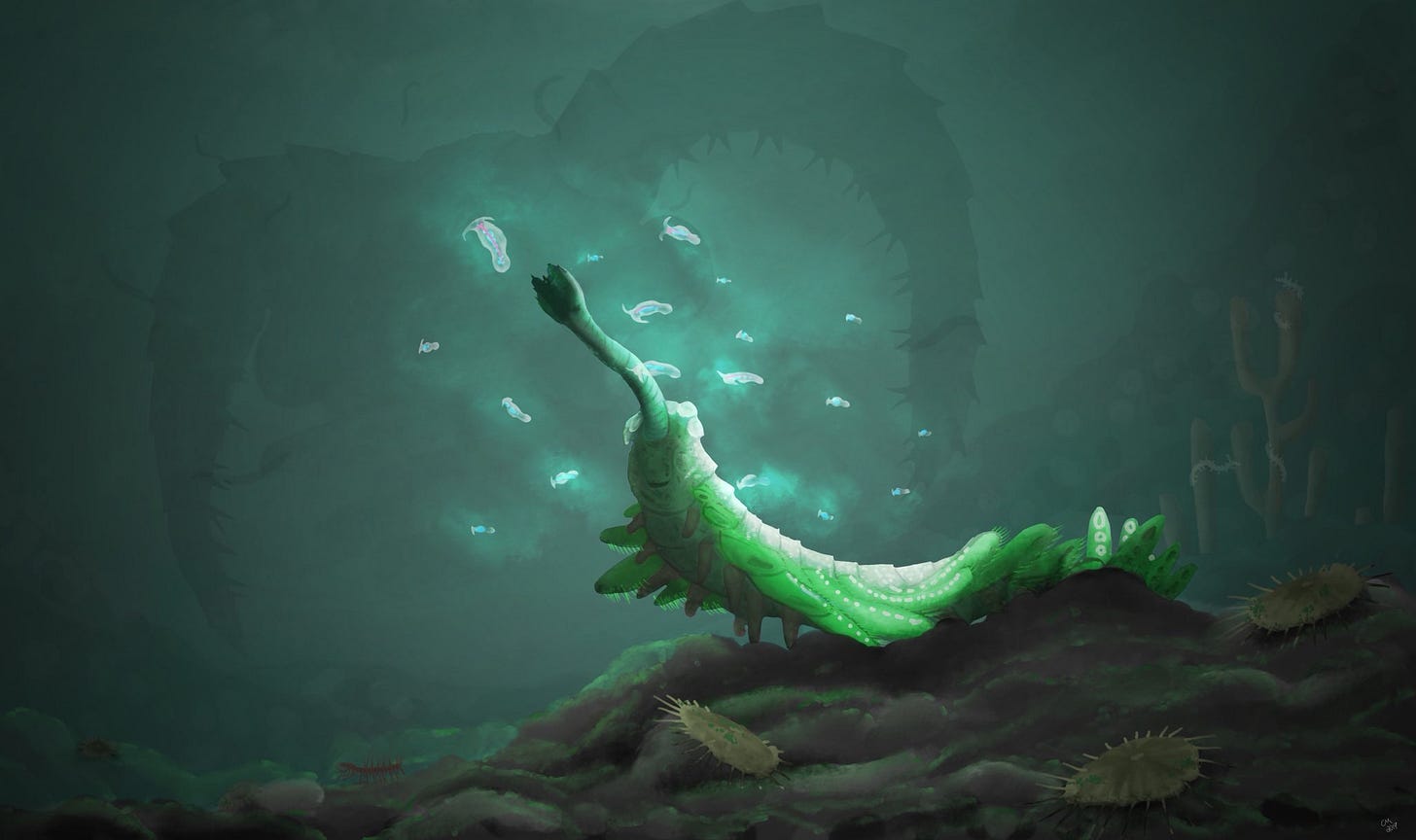
Biological explosions are among the most mysterious events in the history of life. The most famous is the Cambrian explosion, which occurred roughly 530 million years ago. It wasn’t actually a single explosive event; it lasted over 20 million years, but in geologic time this is a blink. Almost all modern animal phyla originated in the Cambrian. Each phyla represents a unique body plan- arthropods, molluscs, and chordates are some examples, among the 40 recognized animal phyla.
There may even be up to nine extinct phyla represented in the Cambrian fossil record. As molecular biologist Kenneth Miller notes3- “This is more than just a bookkeeping change. The phylum is the next-to-highest level of biological classification. Only kingdom is higher, and all animals belong to the same kingdom (Animalia).” These extinct phyla represent entirely different paths animal life could have taken, but, for reasons unknowable to us, they simply didn’t make it. Had any of these phyla survived and prospered, the world would be radically different today, and neither you nor I would ever have been born.
Cambrian animals were bizarre and frightening to behold. The term “Lovecraftian” is an apt description. All of them lived in the sea, for the land and the air were still too inhospitable to sustain life. Glancing at just a handful of Cambrian creatures, we can see potential historic inspiration for Lovecraft’s Great Race of Yith4.
The most famous of the Cambrian fauna is probably the half-meter long Anomalocaris, one of the world’s first apex predators. It silently glided through the murky depths on rippling rows of chitinous fins, the only warning of its presence a long shadow cast on the seabed muck. The white shark and the thresher and the mako welcome companions in comparison to this alien monster.
Anomalocaris saw the world through giant, lidless eyes. These inky black orbs, perched on twin stalks, were a potent innovation in the evolutionary arms race between predator and prey. With over 16,000 lenses, Anomalocaris’s compound eyes were the most advanced in the world, thirty times more powerful than those of its trilobite prey. Their resolution would only be matched 508 million years later by the dragonfly, which has 28,000 lenses. The dragonfly’s eyes are probably the closest analogue to Anomalocaris- both possessing 360° fields of view, and both extremely adept at detecting the movements of their prey. Anomalocaris is even thought to have had dichromatic color vision, like mammals, so it would have had perfect visual clarity as it swept down upon its victims like a marine falcon and darkened the waters with their life fluids.
Two barbed pedipalps hung from its head, covered in tridentine spines and curled like scorpion tails. Lashing out in lightning jabs to snatch trilobites from the seafloor. The spiny appendages pulling their struggling bodies inexorably towards the garbage disposal mouth. Plated teeth, three large and dozens small, opened and closed like a camera shutter, effortlessly crushing fragile exoskeletons. As the prey was dragged to the gnashing maw, it would have felt pain, and an urgent sense of self-preservation, but not fear. Never fear. That sensation hadn’t evolved yet.
Other Cambrian creatures were just as bizarre. Wiwaxia looked like a head of lettuce with twin rows of spines sticking out of it. Opabinia had five eyes and a menacingly clawed trunk. The famous Hallucigenia was so strange that for a long time paleontologists reconstructed it upside down and back-to-front. Many of these Cambrian creatures’ affinities to modern phyla are unclear and very much up for debate, but they were for the most part still related to extant animals in some manner. They all indisputably belonged to the kingdom Animalia.
Sometimes, Cambrian relationships to living organisms are more apparent. If you were to look at Pikaia or Haikouichthys, you may have recognized, through a glass darkly, something quite similar to a fish. They were only an inch long, and were among the first chordates, possessing primitive notochords- the precursor to a spinal column. These humble fishing lures were your direct ancestors, and the ancestors of every other vertebrate. All the tigers and trout in the world, every songbird and every salamander ever born, can trace their ancestry back to these tiny, wormish stem-chordates.
All of these bizarre creatures flourished for millions of years, going forth and multiplying across the briny shoals and the continental shelves and the great trenches of the deep, “searching for the fulfillment of that share of life’s destiny which was theirs according to the plan of Nature.”5 For forty million years, generation after generation, these exotic lineages thrived, until the dawn of the Ordovician.
Another great biological explosion occurred in the Ordovician, the period immediately after the Cambrian. During this radiation, an entirely new fauna appeared, replacing their Cambrian predecessors almost entirely and achieving exponentially greater levels of biodiversity. Twice as much total marine biodiversity was added in the Ordovician radiation compared to the Cambrian explosion. While the Cambrian fauna peaked at about 100 identifiable families, over 350 are known to have formed in the Ordovician. A total of over 4,367 animal genera sprang into existence throughout this period, a quadrupling of diversity constituting 12% of all known animal genera in the Phanerozoic eon. That’s the eon that includes everything after the Cambrian.
This new “Paleozoic Fauna” was far more advanced than the preceding Cambrian fauna. Instead of anomalocarids, giant cephalopods were the indisputable apex predators of the Ordovician seas. Thirty-foot nautiloids such as Endoceras loomed over the crinoid gardens like zeppelins, while smaller ones whipped over in V-formation, archaic fighter jets boring through the pelagos. Their tentacles occasionally lashing out to capture an unfortunate gastropod, or one of the first true fishes. Jawless, covered in bony plates of armor like primeval knights, these little torpedo fish were the result of millions of generations of adaptation from stem-chordates like Pikaia.

The Paleozoic Fauna didn’t just look different from the Cambrian Fauna- it was ecologically different too. Looking at 118 theoretically possible modes of life, Cambrian organisms filled out about 30 of them. In the Ordovician, skeletal organisms alone occupied that many, whereas they only filled 19 in the Cambrian. If the Cambrian is when modern phyla were first formed, then the Ordovician is when they matured and diversified into new families and taxa, able for the first time to fill out many different ecological niches (as an aside, living animals only fill in 92 of these potential ways of life). They appear to have hit an ecological cap by the end of the Ordovician, as the increase plateaus from that point until the Permian-Triassic extinction, in which the Paleozoic Fauna was largely wiped out.
The twin explosions- Cambrian and Ordovician- were unparalleled at any other point in life’s history. While the Modern Fauna fills in more ecological niches and is overall more biodiverse, there are far fewer unique forms, and the scale of the two Paleozoic explosions has never been matched. For perspective, the aftermath of the Permian-Triassic extinction event started with about as few animal species as the Cambrian, but no radically new types of animals evolved6. The increase in biodiversity has also been much more gradual, never again accelerating in the rapid, near-vertical climbs of the Cambrian and Ordovician- according to Erwin et al (1987) it took two pulses of diversification in the Mesozoic to reach 450 new families, only a hundred more than arose in the Ordovician alone.

So what happened? What caused such a rapid increase in biodiversification in these periods and only these periods? What was special about the earliest Paleozoic compared to later periods? What caused the Cambrian and Ordovician explosions?
The Birth of Venus
One of the most far-out theories to account for the Cambrian and Ordovician explosions was proposed by Annabel Cartwright in her 2016 paper “The Venus Hypothesis.” The theory is deceptively simple- rather than the Cambrian and Ordovician explosions being the result of Earth-based evolutionary pressures, the lifeforms came from Venus.
It’s not as silly as it sounds. Professor Alfred McEwen, director of the University of Arizona's Planetary Image Research Laboratory, commented “There has almost certainly been exchange of biota between Earth and Mars. Mars is not very far away. Martian rocks from impact can easily reach Earth; probably Earth rocks also reached Mars from impacts in the past.”
Note that he is not saying Earth was seeded with life from Mars, but rather that life from Earth most likely found its way to Mars on ejecta from impacts, and it may have survived and flourished there for some time, maybe even hitching a meteoric ride back to Earth. This exchange of microbial life might have continued until Mars’s oceans evaporated about 3.2 billion years ago, leaving the planet cold and dead.
The possibility of Earth exchanging biota with Venus, however, has largely been overlooked, mainly because Venus today is such a hellish death world. But it wasn’t always. Venus retained its oceans far longer than Mars7, until at least 600 million years ago, and possibly much, much later, making it an ideally habitable world. Indeed, uninhibited by long, global ice ages like the “snowball earth” periods that afflicted our own world, multicellular life may have arisen even earlier on Venus than here.
It may also have retained some plate tectonics and even a carbon cycle relatively late into its history, though exactly how late is pure speculation, given how little we know about Cytherean geology. The surface is extremely hostile to any kind of exploration- none of the Soviet Venera landers lasted much longer than two hours- so hard data is difficult to come by.
We know Venus suffered a global resurfacing event sometime between 600 and 300mya, wherein the planet’s entire crust was melted down and recycled. There’s a 200% margin of error on either end of the timeline, because the estimates for when resurfacing occurred are based on crater counts. The thinking is that if impact craters are rare and mostly intact, then the crust must be fairly young, but the method is far from precise. Venus has very few impact craters- quite unlike the Moon, where craters overlap other craters- and they are all perfectly uneroded, raw as they day they were made, meaning the Cytherean crust is extremely young, geologically speaking. Venus probably retained some type of water until shortly before the resurfacing, with the seas likely drying into isolated lakes and ponds before all liquid water was finally lost.
Importantly, Venus is much closer than Mars- Mars’s closest approach to Earth varies between 34 and 64 million miles, but Venus comes within 25 million miles. We mentioned at the beginning how Venus’s plate tectonics eventually broke down, leaving the planet’s crust a stagnant lid, with ever-increasing pressure in the mantle beneath. This would provide a perfect mechanism for transporting ejecta to Earth, with impacts and eruptions becoming far more explosive as the planet desperately attempted to vent the pressure, thus flinging ejecta much further and at greater velocities. Relatedly, since Venus is slightly smaller than Earth, its escape velocity is proportionately lower, only 10km/s. If an object left the Cytherean atmosphere at 32km/s- possible with some extra help from the mantle- Earth would only be 150 days away.
The implications of this cannot be overstated. Venus may have been habitable long into the history of life on Earth. If it remained habitable to the youngest estimated resurfacing date, 300 million years ago, then it would have been life-sustaining at the dawn of the Permian. The great Carboniferous rainforests, teeming with two-meter long millipedes and eagle-sized dragonflies, had already long since come and gone, and amniotic reptiles had conquered the land. While eurypterids prowled the seas and sail-backed Dimetrodon basked on sunbaked stones, there may well have been very alien lifeforms teeming on a twin earth, a mere 25 million miles away.

But what if the Cythereans weren’t so alien after all?
Cartwright boldly suggests that the Cambrian explosion and Ordovician radiation both can be attributed to transportation of organisms directly from Venus. The Cytherean fauna was more complex than Earth’s, and so the “explosions” are in actuality artifacts of these more advanced creatures arriving in our oceans, already fully developed. The lack of precursors to Cambrian organisms in the fossil record is handily explained- their precursors were left behind on Venus, where any of their fossils would have been incinerated by the cataclysmic resurfacing.
Okay, all well and good, but why was Venus more able to evolve complex lifeforms than Earth? Radiation. Venus, orbiting only 67 million miles from the Sun, is subjected to twice the solar radiation and solar wind as Earth. Its utter lack of a magnetic field exacerbates the effects. While it may have had a stronger magnetic field in its youth, any organisms living there still would have been subjected to much higher levels of radiation than on Earth, likely leading to accelerated mutation rates, the driver of evolution.
Another difference between Venus and Earth that may have caused greater complexity is a smaller Cytherean water volume. Estimates of how much water Venus once possessed vary- some say it formed with a mere four meters of water, some say it once had as much or more water than Earth. Way et al (2016) calculated that 2.9gya, Venus’s oceans covered about 60% of its surface, giving it a higher land/water ratio than Earth- 40/60 versus 30/70. This water would have begun to evaporate rapidly once the stagnant lid phase began, leaving it with even less ocean. In the large, isolated bodies of water that clung on longer, rapid evolution akin to what occurs on Earth islands may have given Cytherean organisms very unique adaptations as they competed ferociously for ever-dwindling resources.
Cartwright proposes that, while Terran and Cytherean life may have ultimately shared a common ancestry from lithopanspermia- perhaps Venus was originally seeded from Earth?- Cytherean lifeforms would be “wildly more exotic and further advanced than that evolving on Earth.” One is tempted to speculate about what the native Cytherean biota may have looked like in its prime- and wild speculations they would be!- but that is not our purpose here today.
Deep Time Impact
Again, all well and good, but how could complex, multicellular lifeforms possibly survive an interplanetary journey from Venus to Earth? Bacteria on pulverized meteors, certainly, but anomalocarids and nautiloids?
As Venus died, its rotation slowed as well. Today, one Cytherean “day” is equivalent to 116.75 Earth days8, about half of a Cytherean year. These interminable days, of course, mean there are equally protracted nights. On the pitch black night side of the world, the seas would most likely have frozen solid. Cytherean lifeforms would thus have been under intense pressure to evolve deep hibernation states, with high cold resistance. This is completely plausible; many Earth lifeforms can survive freezing with no issue. Alaskan wood frogs survive being near-literally frozen solid for up to seven months, thanks to a natural antifreeze in their bloodstream that prevents individual cells in vital organs from freezing. Some very ancient lifeforms like tardigrades, nematodes, and triops also exhibit such adaptations.
Quoting Cartwright: “Life on the dark, night side of Venus, most likely to be hit by impactors and then launch material to Earth, would be deeply dormant, and probably encased in ice. Ideally prepared for interplanetary travel.”
As the final evidence for the theory, Cartwright notes that there are multiple major impact events that occurred right at the outsets of the Cambrian and Ordovician explosions. Carbonate samples from Cambrian sediments in upstate New York reveal iridium concentrations comparable to those generated by the end-Cretaceous impact, and the Can-Am structure is a ~500 million year old, thirty-mile diameter crater located a mile under Lake Huron in Cambrian basement rocks.
Meanwhile, the Ordovician radiation has been linked to the breakup of the L-chondrite asteroid, about 470mya. Due to this breakup, impact events during the Ordovician are believed to have increased by one or two orders of magnitude, with five large craters in North America and six from Scandinavia dated to the Ordovician.
Venus would also have been hit hard by the breakup- asteroid fragments traveling in elliptical orbits would actually hit Venus at higher velocities than Earth. The extra force behind these punches, combined with the higher pressure of Venus’s mantle, would have thrown enormous chunks of the Cytherean crust into space, with some of that ejecta eventually making its way to Earth. Indeed, these sucking crust wounds may have contributed to Venus’s final destructive resurfacing, while paradoxically the impacts saved some of the planet’s biosphere by casting organisms off in icy arks. Impactors from Venus would be imprinted with traces of L-chondrite material when they hit Earth, so it would be difficult to distinguish Cytherean material from L-chondrite material.
The huge bolides we know about would have been accompanied by a vast retinue of smaller meteors, many of which would have landed in the shallow Ordovician seas and survived the impact. Contrary to popular belief, when entering the atmosphere, only the outer layers of a large meteor burn up. The interior can remain quite cold. When these smaller icy fragments hit the water, they either would have split open or gradually thawed, releasing dormant Cytherean lifeforms into the unsuspecting Terran seas.
The timing matches up eerily well- at the precise point when Venus’s oceans began to wither into a hypercompetitive lake system, the inner solar system was walloped by bolides, and it is at this precise moment that the Cambrian and Ordovician explosions happened.
Thus we are left with an eerie parallel to the Greco-Roman story of Venus Anadyomene. In the myths, Venus is born fully grown from the sea-foam produced by the severed genitals of the primordial deity Uranus. She rides to shore upon a scallop shell, gracing the world with her beauty.
Possibly, in real life, Cytherean lifeforms arrived on Earth from the ashes of their own planet, already “in adult form” and going forth to populate the Terran seas. These bizarre Cytherean creatures would vastly enrich the Earth’s biosphere, eventually becoming the stunning, gorgeous array of creatures we have with us today- including ourselves. Every elephant, every whale shark, every orb weaver… every minute facet of this stunning web of animal life had its roots on Venus. All of our most distant ancestors came here encased in icy caskets, catapulted across the void from a dying world.
The Alien Invasion
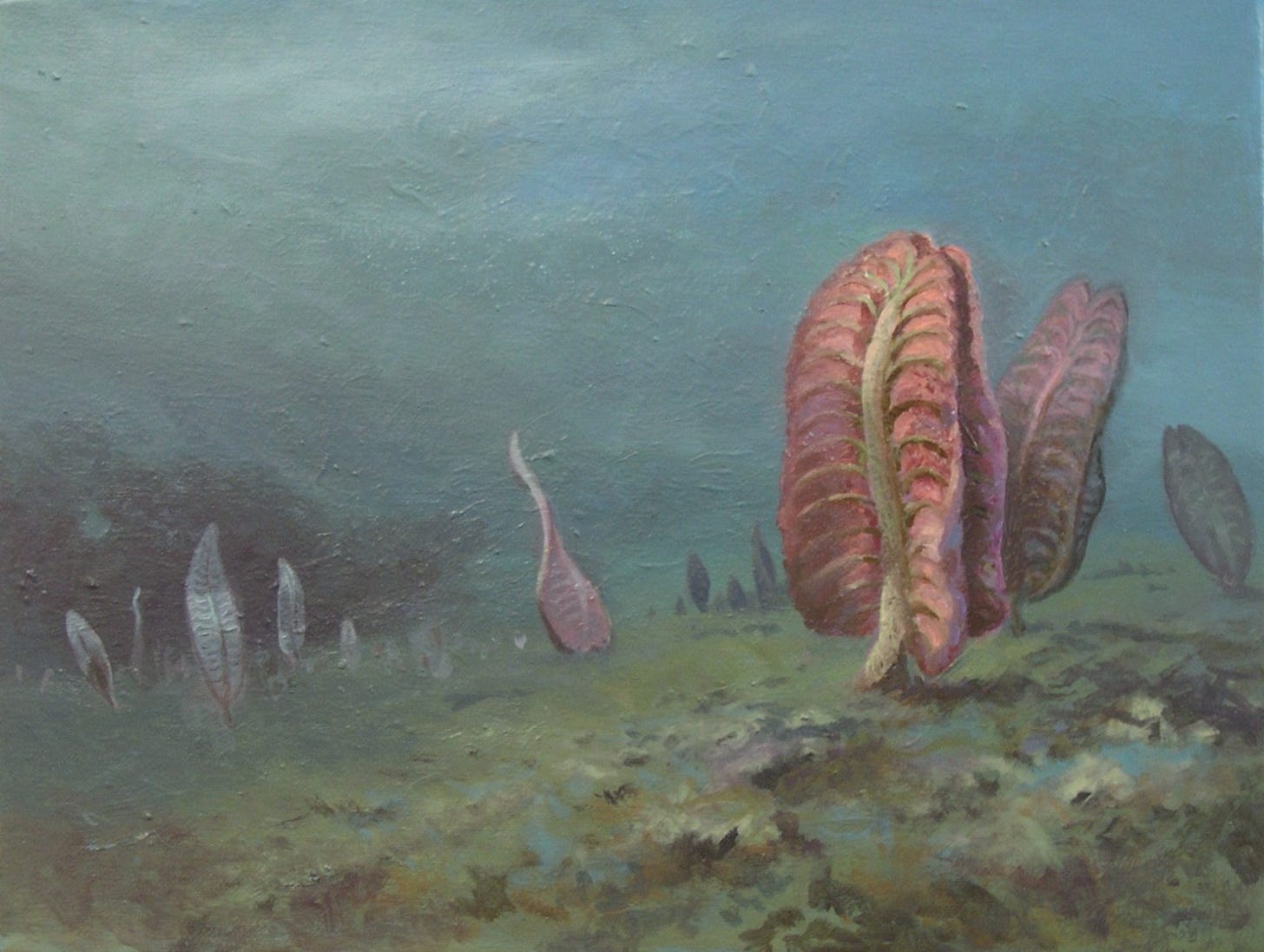
There is, however, a problem with this romantic notion of the Cytherean biota seeding a virgin Earth.
Earth was already occupied.
You see, the Cambrian explosion was not the first explosion of multicellular life in Earth’s history. The Avalon explosion preceded it by 33 million years. It occurred during the Ediacaran period, 575 million years ago, and was the first time complex multicellular organisms had taken over the seas. Fossils from this crucial period of life’s development are found globally, exquisitely preserved in ash. Thanks to this method of preservation, the finest details of these soft-bodied creatures can be discerned. It’s a kind of Precambrian Pompeii, preserving organisms that would otherwise be lost forever to the abyss of time.
Ediacaran organisms were even more alien than the Cambrian biota. Charnia, the first Precambrian organism discovered, belonged to a group of creatures called rangeomorphs. These were immobile organisms that looked like giant fern fronds, standing up to two meters tall, wavering in the currents and soaking up nutrients in a manner similar to sponges and corals. Despite their superficially floral appearance, they weren’t plants- they lived in kilometer-deep waters, far too deep and dark to photosynthesize. But they weren’t animals either. Rangeomorphs grew fractally. Each of their fronds was a smaller version of the whole organism; it’s believed that Charnia and the other rangeomorphs reproduced asexually, by detaching full-grown fronds which would then drift around and root themselves in the seabed elsewhere. There is no living animal- nay, no living organism- that reproduces like this.
Fractofusus was a leaf-shaped rangeomorph. Instead of shooting up like Charnia, it lay flat on the seafloor. It too reproduced asexually, sending out little tendrils in every direction, each tipped with a new bud of Fractofusus. These buds then matured and grew their own runners, until the seafloor was covered in them. Overall their method of reproduction was not dissimilar to strawberry plants. Behold, a Precambrian strawberry:
Dickinsonia was more similar to animals, but it’s debated whether it was actually in the kingdom Animalia, basal to Animalia, or if it possibly belonged to an entire extinct kingdom of life. Several differently shaped species of Dickinsonia are known- some were ovals, and others resembled flattened cones. They looked like thumbprints, with dozens of narrow segments radiating out in a nearly-symmetrical pattern from a central line- not a spine, because Dickinsonia certainly didn’t possess one. It also lacked a mouth or anus, or any kind of recognizable internal organs. It’s unclear if it was even mobile or if it just sat on the seafloor, soaking up nutrients.
Some Ediacarans were mobile, however. Spriggina bears a superficial resemblance to trilobites, with a clearly distinguished head and possibly even eyes, but it’s unclear if it was actually related to trilobites, or if it was even an animal at all. It was about two inches long and possibly predatory. Lacking the bilateral symmetry of animals, it instead appears to have had glide-reflection, with its many body segments shifted by intervals, like footprints on the beach. Its body was tough by Ediacaran standards, but totally lacking in any kind of calcium shell or bone.
Kimberella was also perfectly mobile. It looked vaguely like a slug, eating the dense microbial mat that covered the seafloor at the time. This might be the closest Ediacarans got to developing something like an animal- Kimberella was bilaterally symmetrical, and likely reproduced sexually, given the lack of indication of asexual reproduction. It had a kind of non-mineralized shell that it hid in to ride out the strong currents caused by storms. Some researchers have tried to classify it as a mollusc, but this is contentious.
Tribrachidium looked like it was attempting to become a starfish, but then changed its mind and decided to be a flower instead. Its three arms spiraled inward like a triskelion. This trilateral symmetry is once again totally unlike anything living today- all animals are either bilaterally symmetrical or not symmetrical at all (in the case of corals and sponges). Not even plants or fungi exhibit such a unique growth pattern. Again, Tribrachidium was not an animal, and instead appears to have belonged to a separate, totally extinct kingdom of life.
Cloudina is the first creature believed to have had a type of skeleton, consisting of a long tube of nested cups. But it didn’t use its proto-skeleton to brace its body and protect its nervous system from the stresses of rigorous motion, as chordates would millions of years later. It actually was the first known reef builder. Think about this- there is no reason to think the invention of the skeleton would necessarily lead to mobile creatures like us. Just as easily, there could have been an alternate timeline where calcium skeletons led only to immobile reefs. Nothing about our current age was inevitable; rewind the clock back to the Ediacaran, and things may have turned out completely different.
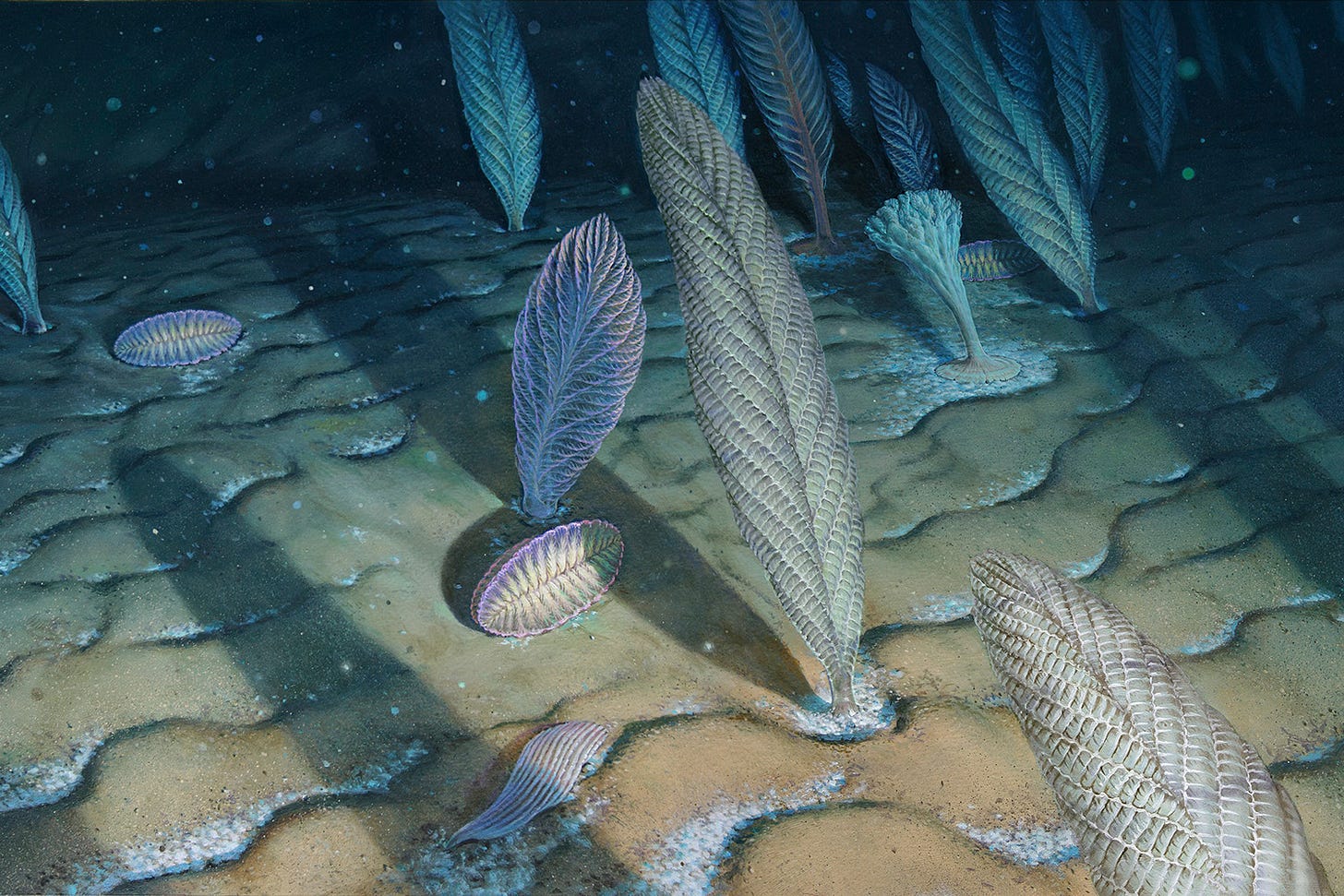
The weirdness of Ediacaran lifeforms raises a tantalizing question- do living Earth organisms share any ancestry with them? Presently, it’s unclear. Some researchers think the Ediacaran biota were definitely animals- animal defined as belonging to the kingdom Animalia- with others representing offshoots from the stem of Animalia. But others, such as paleontologist Mark McMenamin, believe they weren’t animals at all, and that they represent an entirely different kingdom of life- maybe even several kingdoms- which went totally extinct before or during the Cambrian explosion. This would make the Ediacarans a failed attempt at multicellular life, a false-start on the road to complex organisms like us.
I want to stress this point- despite converging with animals and filling in ecological niches that animals would later fill, the Ediacaran biota did not belong to the kingdom Animalia and thus were not animals. They were something else.
Startlingly, McMenamin stated that since Ediacarans didn’t possess an embryonic stage, they couldn’t have been animals, but they did independently evolve nervous systems and even brains, suggesting that “the path toward intelligent life was embarked upon more than once on this planet." But whatever degree of intelligence sessile rangeomorphs may have obtained, it would have been totally unlike the intelligence of animals; oriented more towards interpreting chemical signals than governing motion.
The implications of this are deeply unsettling. There was an entirely different, aborted attempt at multicellular life, one with its own unique approaches to multicellularity and intelligence, one with its own memories, that went totally extinct.
The Ediacarans didn’t make it to the end of the Cambrian; there appears to have been a major extinction event at some point- we can’t say for sure whether it occurred in the Ediacaran or in the early Cambrian- that wiped them all out. There are, of course, many different theories as to what could have caused their extinction. Various mechanisms of climate change, preservation bias masking a potential late survival, and them simply evolving into more advanced forms that did survive into the Cambrian have all been proposed, but none are generally accepted.
The possibility that we will discuss here is considered the most likely- that Ediacarans were outcompeted by Cambrian lifeforms. This theory exists independent of the Venus Hypothesis, but can be linked to it without much effort.
Remember, the Venus Hypothesis is that the Cambrian explosion was caused by dormant Cytherean organisms- far more advanced than the Ediacarans- being dropped into our seas by meteors. So, what if the Ediacarans didn’t go extinct before the Cambrian explosion? What if they were right there when it happened?
What if they were replaced by Cythereans?

This is a disturbing thought. The truly native Earth biota would have been severely outclassed by the incoming Cythereans, which had a much longer history of multicellularity and evolved in a more competitive environment.
Original Earth life didn’t go totally extinct- jellyfish and sponges existed long before the Ediacaran, and are obviously still around, to say nothing of plants and fungi- but a majority of Ediacarans were wiped out by this biotic exchange. Charnia, Dickinsonia, Tribrachidium, Spriggina- the true heirs of Earth, the biosphere’s first successful attempt at multicellularity, were cut down by far more advanced, more competitive Cythereans who wound up here accidentally.
Consider- the nightmarish Cambrian creatures we discussed, our ancestors, may not have even been the largest organisms in the Cytherean lakes and seas. It would be more likely for smaller organisms to survive the journey across interplanetary distances, rather than large macropredators. The ancestors of Anomalocaris and Opabinia, if they were indeed originally from Venus, may have been small fry on that lost world. When they arrived on Earth, with their natural predators absent they simply overran the oceans. With identical biochemistries, thanks to the aforementioned lithopanspermia, these Cambrian-Cytherean predators would have had no trouble devouring Ediacaran lifeforms, just like how cats and rodents cause the extinctions of ground-nesting birds when they get loose on islands that previously had no predators.
The Ediacarans were competitive on Earth, replacing the previous non-microscopic tenants of the oceans, giant protists- single-celled organisms that looked like bone white loofahs. But they were no match for the far more voracious Cythereans. While thirty unique modes of life were utilized by Cambrian organisms, the Ediacarans only filled in twelve. Mobile, predatory organisms arriving from Venus, far more advanced in their carnivory than Ediacarans like Spriggina, would have been catastrophic for the largely sessile Ediacaran ecology. They couldn’t run from Cytherean pincers and mandibles.
Aside from the obvious trouble presented to immobile organisms by the appearance of very hungry, very mobile ones, the Cytherean invasion would have also involved a wholesale scything of the lowest level of the Ediacaran ecology- the microbial mat. In the Ediacaran, the seafloor wasn’t simply sandy mud like it is today. It was solid soil, a thick, tight-knit mat of bacteria. All known Ediacaran organisms either lived on top of this mat or, in the case of the rangeomorphs, rooted themselves in it, but none burrowed under it. The microbes that formed the mat sucked all the oxygen out of the sediment, and sometimes produced toxic hydrogen sulfide, making it a no-go zone for Ediacarans.
But priapulid worms- mysteriously originating in the late Ediacaran and still alive today- were able to handle the toxic environment, burrowing through the microbial mat the Ediacaran biota was dependent on. Like a vast termite infestation, priapulid burrows weakened the microbial soil until it was unable to support the stems of rangeomorphs. These keystone Ediacaran species were thus simply blown away by the currents. The worms also used their burrows to hunt, springing out in ambush at any passing organisms and likely causing the extinction of the few mobile Ediacarans to satisfy their voracious appetites.
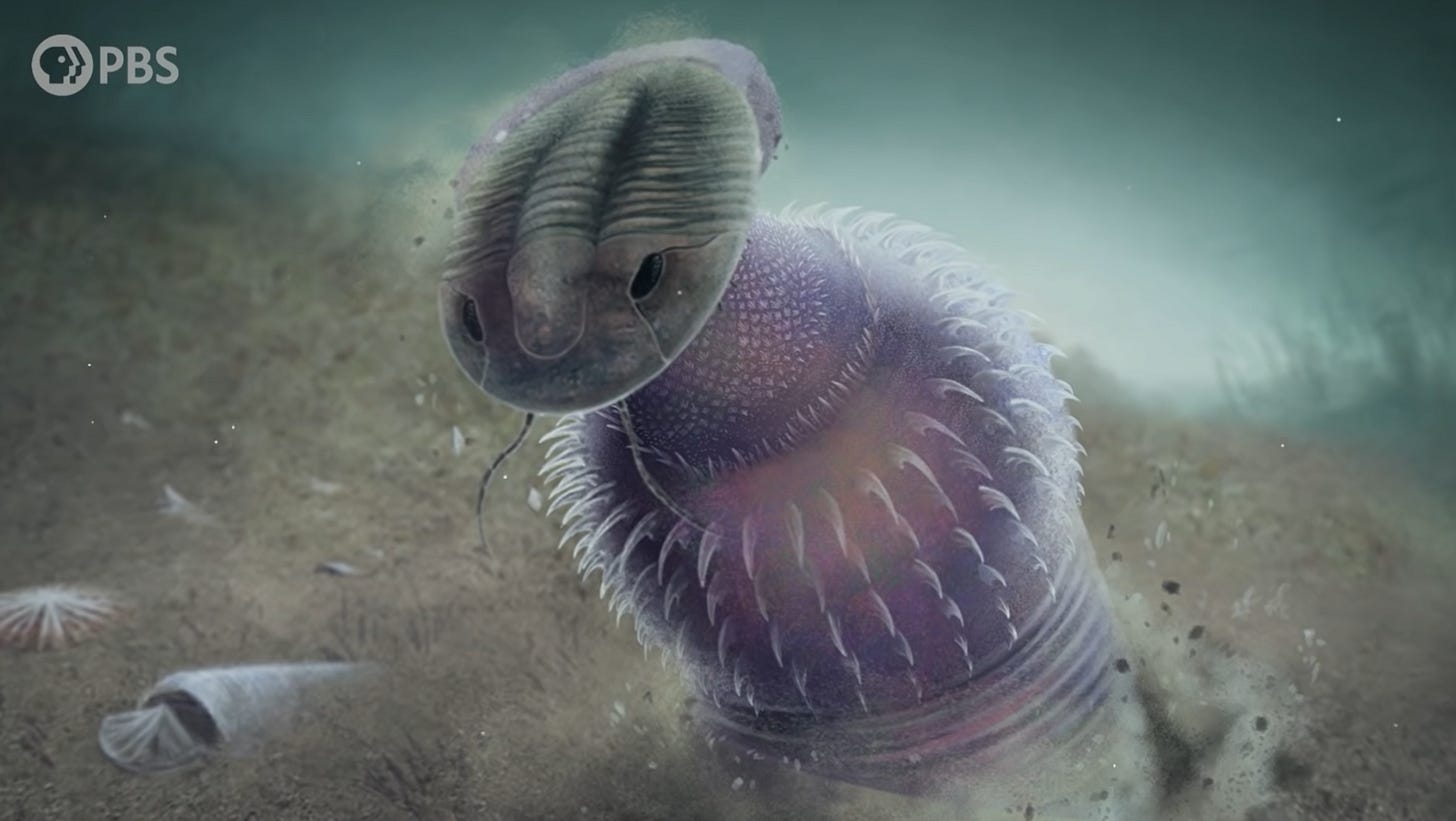
Earth’s original lifeforms would have had no way of responding to such a rapid and thorough conquest, no possibility of competing with organisms living in niches that hadn’t previously existed on this planet. In a matter of- decades? centuries?- the slate would have been wiped clean. There was no place for fractal and trilateral organisms in the new Cytherean order of the Cambrian. If the Ediacarans had, in their most primitive brains, any capacity to dream, those dreams would have been shattered in the voracious maw of Anomalocaris.
But remember what we went over earlier- the Cambrian fauna were animals, they belonged to the kingdom Animalia. The Ediacarans were not animals. And if the Venus Hypothesis is true, this means that animals came from Venus9. It’s impossible to overemphasize this- Ediacaran non-animal life was replaced by animalian life from Venus.
An alien invasion wiped out most Terran life at the dawn of multicellular evolution.
And all living animals are the legacy of those invaders.
We are the aliens.
Sources
The Venus Hypothesis, Cartwright (2016)
Precambrian Creatures: The First Animals by The Budget Museum
The Other Explosion You Should Know About by PBS Eons
Was Venus the First Habitable World of our Solar System? Way et al (2016)
General information about Venus
Can-Am (Probable) Impact Structure, by Charles O’Dale
AUTECOLOGY AND THE FILLING OF ECOSPACE: KEY METAZOAN RADIATIONS, Bambach et al (2007)
The Ediacaran Period: Glimpses of the Earth's Earliest Animals
How Worm Holes Ended Wormworld
The Great Ordovician Biodiversification Event by Barry D. Webby, Florentin Paris, Mary L. Droser, Ian G. Percival
The Garden of Ediacara by Mark McMenamin
The Dog Stars by Peter Heller
Finding Darwin’s God by Kenneth Miller
The Shadow Out of Time by H.P. Lovecraft
A Canticle for Leibowitz by Walter M. Miller
There may be practical reasons for this, at least among certain types of animal- the tetrapod form, for example, is quite good, so there may simply have been no reason (or way) to evolve an entirely new body plan from it. The lack of radiation is less explicable, however, when discussing invertebrates.
There is some debate over whether Venus actually had oceans or not. It seems likely that it did, due to the presence of some older felsic crust that would have required water to form. For the purposes of this essay I am of course assuming that it did.
I am using the Cytherean solar day here, not the sidereal day. The solar day is the time it takes for the Sun to come back to the same position in the sky from the planet’s surface, and thus more relevant for things that live there. The sidereal day is a more astronomical term, amounting to 243 Earth days.
I’m oversimplifying a little; it’s possible that the kingdom Animalia developed first on Earth (sponges are technically animals) and was carried to Venus by panspermia, and then brought back to Earth in more advanced form.

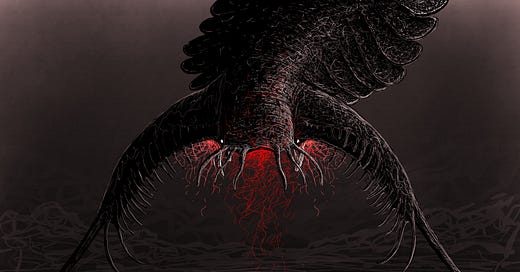



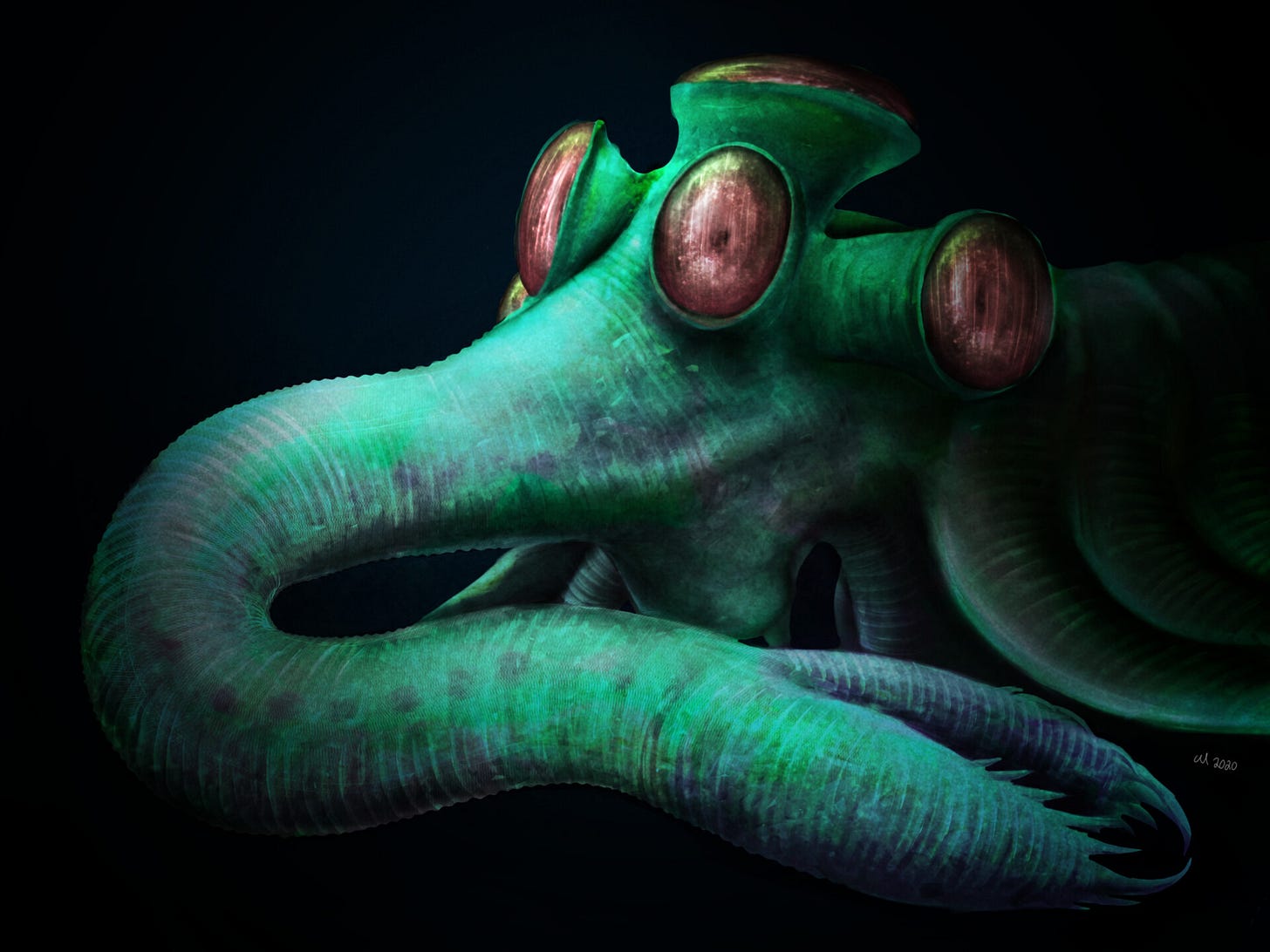








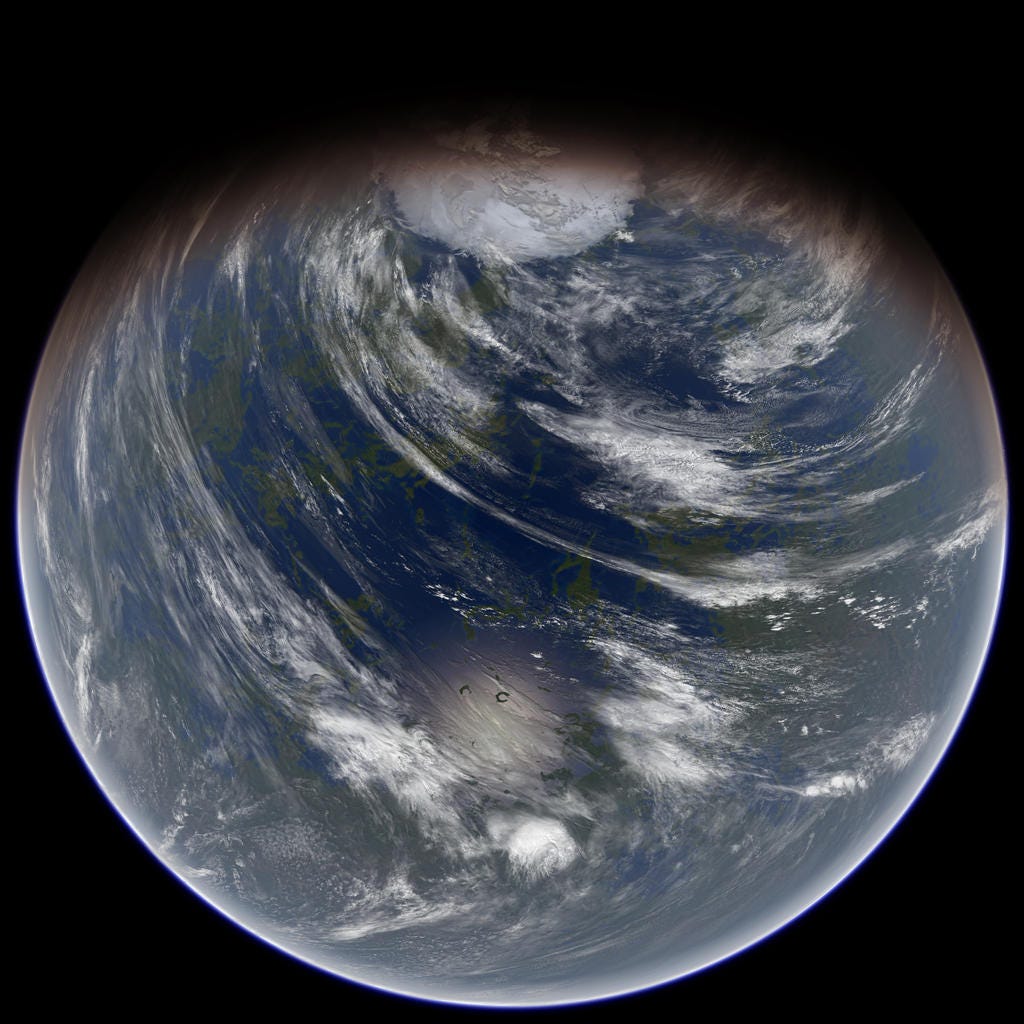
Great in depth dive into this rather esoteric and spooky theory!
Love the theory and thanks for putting together a well constructed argument. Main counter argument that springs to mind is the traceable lineage of animalian proteins in protozoan ancestors (the choanoflagellates).